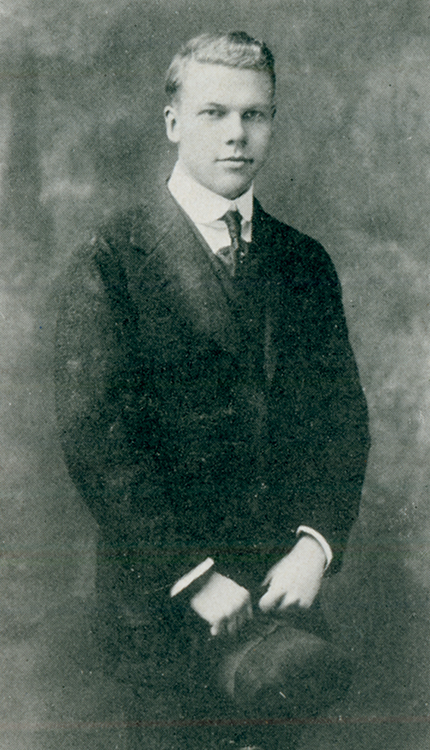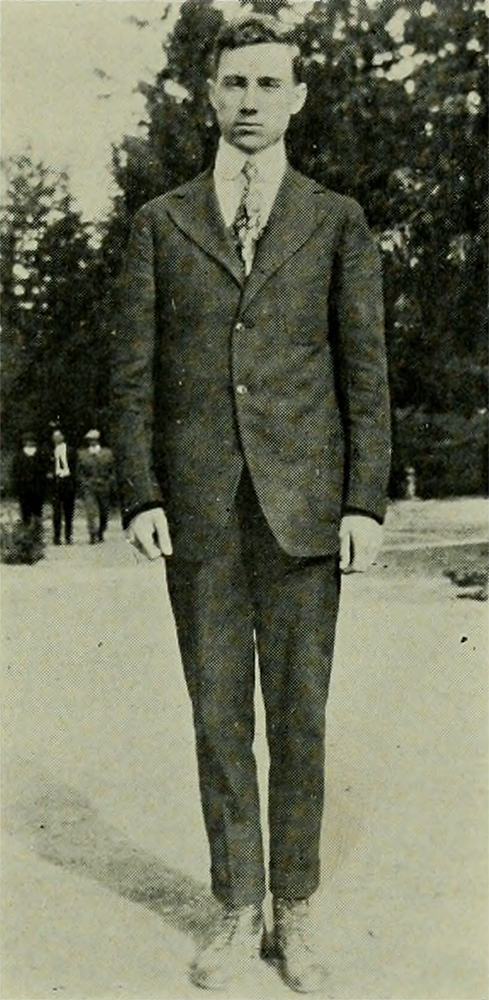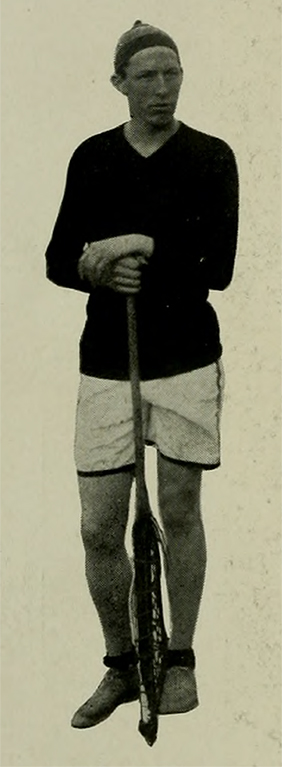Personal Accounts
Each account is an excerpt from oral histories collected in 1973 by University of Maryland students who interviewed former M.A.C. cadets. Audio recordings and complete histories are available in the University Archives.
Kenneth Grace

Kenneth Grace, pictured as a senior at M.A.C. in the 1915 Reveille yearbook.
Kenneth Grace left campus for Thanksgiving in November 1912, but remembers how the fire affected his time at Maryland Agricultural College.
"I came down home on the weekends and somebody called me up around here or told me that they had a big fire over there at College Park. And then when I went back up there, the old barracks, that was a big, white building -- looked kind of like a castle, you know -- well, it was just about a shell up there, and all smoked up and everything like that. And the school just grouped us together, I think by classes, and got room and board for us down in Hyattsville...
... Somebody around here told me about it that heard from it, see? Because I didn't think anything particular about it and I had no reaction a whole lot as to what would happen or anything like that. See, I was awful young when I went up there, I guess, so fine for me, anything like that.
And we went right on to classes. They had it pretty well organized.
Of course when I came home for the weekend I packed up right good, and I had everything like clothing and things like that, but I certainly didn't remember... didn't lose anything valuable because I didn't have anything valuable. I didn't even have a watch or anything, but I guess some did. I'm sure they did.
We, at one time, when we got into this big, what is it -- this new building, Calvert Hall. I had a nice room there and I had a great big square trunk; and of course we went up to school there in the fall and the hills were just full of apple orchards and things like that, and a great many of them were experiments, carrying on and everything, so I used to go out, and lots of others -- I'm not the only one, they were all there -- and loaded up with apples and slip in later on and stow them away. And I'd put mine in my big trunk. Well, anybody later on could walk in that room, they could smell apples all over the place, see? But they didn't fuss about it. And so it was all right, those apples. They just gradually aged until they were almost cider, but they were apples. And then I used to get into everything, 'pert near.
Like going up in the science hall one night. Before we went up there we saw some beautiful apples there on big tables at least this wide and maybe from here to the window. They were specimen apples, they helped us teach horticulture to fellows going to classes. So, one night we decided that we ought to get over there and get some of those apples and eat them. Boy, we got in there all right, no trouble at all, it was practically open anyhow, got in there, reached in to a beautiful, big apple, took a bite in it -- wax! The whole thing was wax. But they were well made, but there were things like that.
You remember the old chemistry building; well, right along side of it was that brick building, gymnasium we called it, and they had a few things like basketball cages -- what is it?-- and all that; but we would run around there, around and around and around this floor, you know, and lifting our knees up and down."
This account was recorded and transcribed from an oral history interview in 1973. Cite as Maryland Manuscript item 1202.
Lee Pennington
Lee Pennignton, called, "Duck" as a cadet, hailed from Havre de Grace, MD. He was present to witness the fire and describes several theories as to how and why efforts to stop it failed.
"Freshmen were called rats. They had very strict rat rules. Frequently we were hazed to the nth degree. I've had to run gauntlet races up on the halls. I've had to get up on a table and either sing or recite and then they'd sometimes knock the table out from under you, and infrequently somebody'd get hurt.
Well, I got safely through the freshman year, and that was in 1912. Coming back in the fall of 1912, I was a sophomore. In reality, the failure to save the two buildings, barracks, that we had... the old barracks built in 1856 and I do not recall when the new barracks was built... But anyhow the failure can date right back to May, 1912, when we had a baseball game with our then greatest rival, St. John's of Annapolis. We licked them in baseball, and everybody started celebrating.
Due to the fact that we were a military school, we all had rifles in our rooms in the barracks. We had blanks, and we had real cartridges. Some overenthusiastic member of our military corps turned around and shot a hole in the big water tower, which was up behind the old agricultural building. Water was squirting out and another man and I, Kenneth Grace -- later anchor man on the relay team -- and I climbed up the crosspiece rungs of the water tower, found out we couldn't quite reach it, so we came down and got two brooms and a wooden plug and plugged it up.
So, during the Thanksgiving holidays in 1912, most of the students were on vacation. There was a dance, and it was a propitious moment for letting the water out of the water tank in order to have men come out there and insert a metal plug. So during the dance, at the intermission, some of the boys went up to one of the rooms of the new barracks. Apparently, they threw either a cigarette or a lighted match in the wastepaper basket. When the fire alarm rang out, I, who had not gone to the dance, ran to my fire station at the north end of the old barracks, grabbed my hose and no water came out. As a result, when we could have gotten the fire out at the initial alarm, lack of water made that impossible.
From Washington, fire engines were shipped out on the B&O Railroad on flat cars. No provision had been made to be able to take them off the flat cars. So they just had to sit on the flat cars while the barracks burned.
We had a few interesting experiences that evening. Due to the fact that we kept ammunition in our rooms, you could hear bullets going off all during the night. Those of us who were there cleared out as many rooms as possible and placed the belongings of the cadets down at the old flagpole, where the chapel now stands. Some scavengers from Lakeland, thinking perhaps they could pick up a little bit of loot, came up to the vicinity of the flagpole and we saw them beginning to filch clothing and stuff. So several of us cut loose at them with blank cartridges. You sure could hear them yellin' going over the hill.
From then on, we were not in the barracks at all. We were farmed out to private homes in Berwyn, Riverdale, and Hyattsville.
Those of us who were there at the dance had to take their dates back. Those of us who were not at the dance just lay out on the ground around the flagpole, safeguarding the uniforms that we had been able to save. We were not able to save anything but uniforms due to the fact that we were not allowed to keep civilian clothes in our rooms, and they were all in the locker rooms in trunks and so we lost all our civilian clothing.
I lived initially in a home in Riverdale. The three of us didn't like it, so we got transferred to a home down in Hyattsville. I remember this lady whose house we lived in way up on top of the hill -- I think it was called Ravenswood. She tried to get her youngest daughter and me interested in marrying, but she didn't. She liked me, and I liked her, but we were not interested in each other.
The school paid the rent, and she believed in spiritual stuff, and every once in a while when we weren't studying she'd get us in the dining room with a little table and put her hands on it and try to get the table to lift. It wouldn't lift while I was there, so I was finally kicked out due to the fact that I was a nonbeliever.
"Duck" was my nickname in college. You see, I came from Havre de Grace, Maryland, the greatest wild ducking area in the Eastern United States."
This account was recorded and transcribed from an oral history interview in 1973. Cite as Maryland Manuscript item 1207.

Lee Pennington, pictured as a senior in the 1915 Reveille yearbook.
Edwin Powell

Edwin Powell, pictured as a sophomore in the 1912 Reveille yearbook.
Edwin E. Powell is unofficially known as the "father of lacrosse" at Maryland. He organized the first varsity lacrosse team in 1910 and was an avid supporter of the program as an alumnus. Powell was a junior in Fall 1912 and witnessed the fire that devastated the Maryland Agricultural College. Powell took many of the photographs that appear on this website, having donated the images to the University of Maryland Libraries many years after the event.
After graduating from M.A.C. in 1913, Powell became a road builder in Western Maryland and worked in building construction in New York and Connecticut. He served 18 months in France during World War I and later returned to work in management for Mack Truck, the Pennsylvania and Illinois Bureaus of Public Roads, and for Black & Decker.
"We had a civilian inspector -- night watchman -- who watched two buildings. He was the one who discovered the fire. The fire was in my senior year.
That was the way I made my extra money. I had charge of the dining room for the food that they had at the dance. In the interval between my junior year and senior year, Professor Spence, who was on the board, sent for me when I was up on this road job at Beltsville, and he said that he didn't want me to be waiting on the tables as a senior. So, he asked me what experience I had with electricity; and I told him at one time I had worked in a moving picture parlor and I had taken an electrician's license. Okay, he said, we'll make you a college electrician. You'll have to supply the burnt-out bulbs and any short circuits or anything like that, you'll fix. So, that was the scholarship that I had.
As a result of the fire... We were scattered into the various homes throughout College Park, Riverdale, Berwyn, and Hyattsville, just to get rooms for the boys. There was four of us in two houses, four in each house, adjacent to each other. One of them was the Carroll home. On main university drive, College Drive -- is that what it is called now? ... or University Drive; I don't know which it is. Well, anyway, it's the main road that went down to the streetcar tracks. The eight of us ate at the Carroll home. They supplied the food. The eight of us decided that, in view of the fact that the college was down and the military was all off, and we didn't have it any more, that we would organize a fraternity. And so the eight of us formed the Gamma Pi Fraternity, which in 1917 was taken into the Sigma Nu fraternity. At the present time, there's only two of those eight living.
It was just wiped out. The whole thing was wiped... Nobody had any uniforms or anything, you know. There was a few of them that were there that managed to get into the trunk room and throw their trunks out the window. But whether or not they got their own uniforms or not, I don't know. But there was very little saved. I saved the college records -- the kids' records out of the record room -- because that was on the ground floor, and we got in there. But that was all.
I don't know whether you remember or whether you've ever heard about it, but the barracks sat up on the hill there where the old administration building is, and where the old dining room is behind it, and out in the front there was the parade grounds where we drilled. At the end of the parade grounds there was a great big flagstaff, and on either side of the flagstaff were two old cannons and two piles of cannon balls. That's where we played lacrosse, out on the parade grounds."
This account was recorded and transcribed from an oral history interview in 1973. Cite as Maryland Manuscript item 1208.



